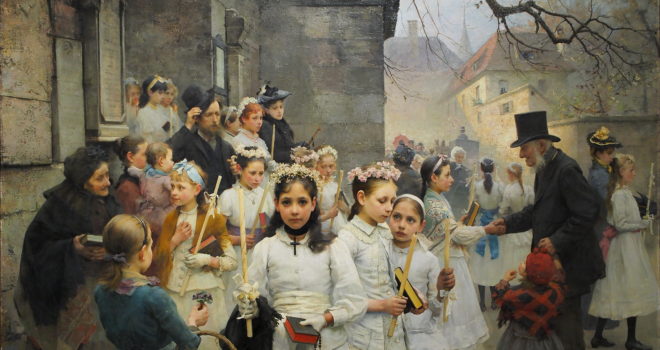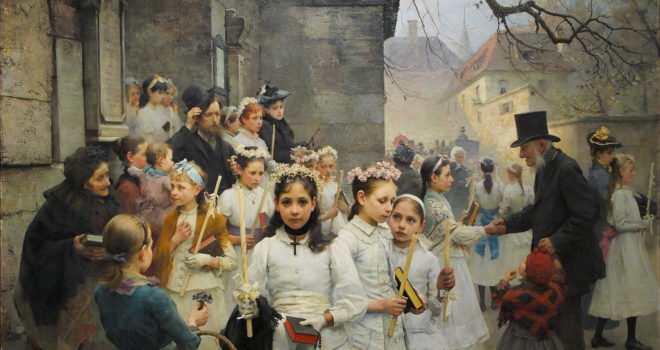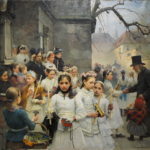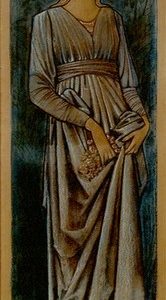Most Catholics know that the month of May is dedicated to the Blessed Virgin Mary. Perhaps your parish holds a May Crowning, a lovely ceremony where children—usually young girls—adorn a statue of Mary with a wreath of flowers while the congregation sings a Marian hymn. And of course the greatest Marian apparition of modern times, that of Fatima, occurred of May 13, the Feast of Our Lady of the Blessed Sacrament.
The origin of May’s association with Mary is obscure. In the thirteenth century King Alfonso X of Castile (c. 1252-1284) wrote a book of poems about the Virgin Mary called Cantigas de Santa Maria, which mention several dates in May dedicated to Our Lady. Specific acts of consecrating the entire month to Mary appear to have begun in Italy in the 1600s. By the 1700s bishops throughout Italy were emphasizing Our Lady during the month of May. A zealous promoter of the devotion in Rome during this time was the Jesuit Fr. Latomia of the Roman College. Fr. Latomia consecrated May to the Blessed Virgin to counteract the vices he noticed among the students. Fr. Latomia’s example prompted others to make similar consecrations of the month. Pope Pius VII (1800-1823) gave papal sanction to the devotion by offering an indulgence for anyone who honored the Blessed Virgin with some special homage or devout prayers during May, either in public or in private. In 1945, Ven. Pius XII put solemnized the Marian nature of the month by establishing the Feast of the Queenship of Mary on May 31.
Another May custom was the planting of Mary Gardens, also known as Paradise Gardens. Mary’s virtues had long inspired spiritual writers to compare her perfections to flowers blooming in a garden of grace. Common people saw allegorical representations of the Virgin Mary in the flowers that grew around them. These flowers would be planted in special gardens that blossomed during May, a beautiful reminder of the special prerogatives of the Blessed Virgin. Three of the most popular Mary flowers were the rose, lily, and marigold, which represented her love, purity, and heavenly glory. Many flowers today have Marian nicknames. For example, Bachelor Button (cornflower) was Mary’s Crown; the common English daisy is Mary Love, and the geranium is Mary’s Flower. The morning glory was Our Lady’s Mantle, the pansy is Our Lady’s Delight, the petunia is Our Lady’s Praises, and so on.
We cannot talk about May without discussing the lovely custom of the May Crowning. Pope Clement VIII (1592-1605) performed the first recorded May Crowning in the west when he crowned the famous Marian icon known as the “Salus Populi Romani” in the basilica of Santa Maria Maggiore. The pope’s impetus for this is unknown; it was perhaps inspired by early Eastern customs of decorating Marian icons during May. At any rate, the pope’s example spread throughout Italy. Parishes organized their own May Crowning, sometimes featuring lavish processions.
With this seasonal focus on the Blessed Virgin, it is not surprising that special hymns were written to celebrate her. “Queen of May” is a title popularly attributed to her in seasonal hymnary. For example, the hymn “Hail Virgin, Dearest Mary,” which begins, “Hail Virgin, dearest Mary! Our lovely Queen of May! O’ spotless, blessed lady!” The German-speaking countries had a hymn called “May Queen” which began, “Mary, Queen of May, we come to greet you. O dear donor of joy, look at us at your feet.” And, of course, the English hymn “Queen of May,” which is sung in many Catholic parishes today on the occasion of the May Crowning.
Variations of these devotions spread from Europe throughout the Catholic world, with May devotions to the Blessed Virgin being found as far abroad as Lithuania, India, and the Philippines.
Save for the May Crowning, most of these devotions fell by the wayside after the Second Vatican Council. Thankfully, Catholics today have a lively interest in recovering their spiritual heritage. Moved by zeal for the faith and a desire to recover the riches of our inheritance, pious Catholics are returning to the font of Mary to drink deeply from her graces. May our own souls bloom with spiritual fruits of devotion to Our Mother even as the Mary Gardens blossom with fragrant reminders of the beauty and splendor of the Queen of May.
✠
Image: After First Communion (Carl Frithjof Smith, 1892)












